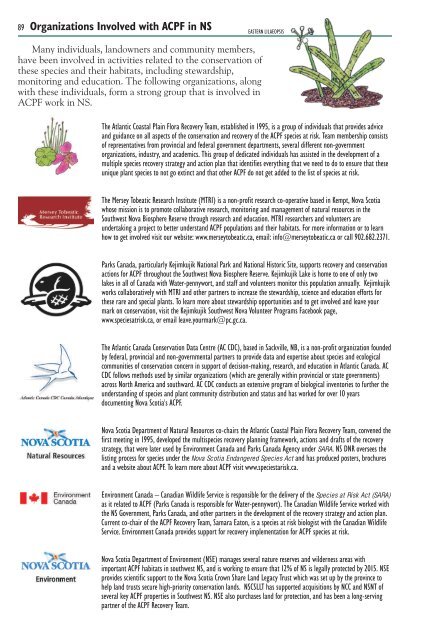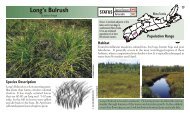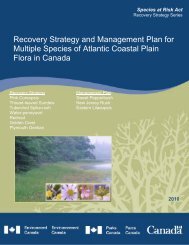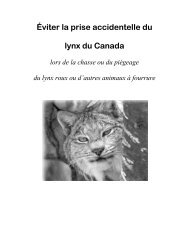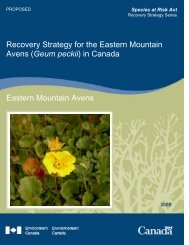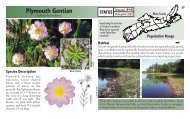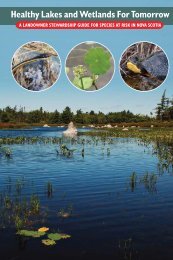Organizations Involved with ACPF in NS Com Org - Species at Risk
Organizations Involved with ACPF in NS Com Org - Species at Risk
Organizations Involved with ACPF in NS Com Org - Species at Risk
You also want an ePaper? Increase the reach of your titles
YUMPU automatically turns print PDFs into web optimized ePapers that Google loves.
89 <strong><strong>Org</strong>aniz<strong>at</strong>ions</strong> <strong>Involved</strong> <strong>with</strong> <strong>ACPF</strong> <strong>in</strong> <strong>NS</strong>EASTERN LILAEOPSISMany <strong>in</strong>dividuals, landowners and community members,have been <strong>in</strong>volved <strong>in</strong> activities rel<strong>at</strong>ed to the conserv<strong>at</strong>ion ofthese species and their habit<strong>at</strong>s, <strong>in</strong>clud<strong>in</strong>g stewardship,monitor<strong>in</strong>g and educ<strong>at</strong>ion. The follow<strong>in</strong>g organiz<strong>at</strong>ions, along<strong>with</strong> these <strong>in</strong>dividuals, form a strong group th<strong>at</strong> is <strong>in</strong>volved <strong>in</strong><strong>ACPF</strong> work <strong>in</strong> <strong>NS</strong>.The Atlantic Coastal Pla<strong>in</strong> Flora Recovery Team, established <strong>in</strong> 1995, is a group of <strong>in</strong>dividuals th<strong>at</strong> provides adviceand guidance on all aspects of the conserv<strong>at</strong>ion and recovery of the <strong>ACPF</strong> species <strong>at</strong> risk. Team membership consistsof represent<strong>at</strong>ives from prov<strong>in</strong>cial and federal government departments, several different non-governmentorganiz<strong>at</strong>ions, <strong>in</strong>dustry, and academics. This group of dedic<strong>at</strong>ed <strong>in</strong>dividuals has assisted <strong>in</strong> the development of amultiple species recovery str<strong>at</strong>egy and action plan th<strong>at</strong> identifies everyth<strong>in</strong>g th<strong>at</strong> we need to do to ensure th<strong>at</strong> theseunique plant species to not go ext<strong>in</strong>ct and th<strong>at</strong> other <strong>ACPF</strong> do not get added to the list of species <strong>at</strong> risk.The Mersey Tobe<strong>at</strong>ic Research Institute (MTRI) is a non-profit research co-oper<strong>at</strong>ive based <strong>in</strong> Kempt, Nova Scotiawhose mission is to promote collabor<strong>at</strong>ive research, monitor<strong>in</strong>g and management of n<strong>at</strong>ural resources <strong>in</strong> theSouthwest Nova Biosphere Reserve through research and educ<strong>at</strong>ion. MTRI researchers and volunteers areundertak<strong>in</strong>g a project to better understand <strong>ACPF</strong> popul<strong>at</strong>ions and their habit<strong>at</strong>s. For more <strong>in</strong>form<strong>at</strong>ion or to learnhow to get <strong>in</strong>volved visit our website: www.merseytobe<strong>at</strong>ic.ca, email: <strong>in</strong>fo@merseytobe<strong>at</strong>ic.ca or call 902.682.2371.Parks Canada, particularly Kejimkujik N<strong>at</strong>ional Park and N<strong>at</strong>ional Historic Site, supports recovery and conserv<strong>at</strong>ionactions for <strong>ACPF</strong> throughout the Southwest Nova Biosphere Reserve. Kejimkujik Lake is home to one of only twolakes <strong>in</strong> all of Canada <strong>with</strong> W<strong>at</strong>er-pennywort, and staff and volunteers monitor this popul<strong>at</strong>ion annually. Kejimkujikworks collabor<strong>at</strong>ively <strong>with</strong> MTRI and other partners to <strong>in</strong>crease the stewardship, science and educ<strong>at</strong>ion efforts forthese rare and special plants. To learn more about stewardship opportunities and to get <strong>in</strong>volved and leave yourmark on conserv<strong>at</strong>ion, visit the Kejimkujik Southwest Nova Volunteer Programs Facebook page,www.species<strong>at</strong>risk.ca, or email leave.yourmark@pc.gc.ca.The Atlantic Canada Conserv<strong>at</strong>ion D<strong>at</strong>a Centre (AC CDC), based <strong>in</strong> Sackville, NB, is a non-profit organiz<strong>at</strong>ion foundedby federal, prov<strong>in</strong>cial and non-governmental partners to provide d<strong>at</strong>a and expertise about species and ecologicalcommunities of conserv<strong>at</strong>ion concern <strong>in</strong> support of decision-mak<strong>in</strong>g, research, and educ<strong>at</strong>ion <strong>in</strong> Atlantic Canada. ACCDC follows methods used by similar organiz<strong>at</strong>ions (which are generally <strong>with</strong><strong>in</strong> prov<strong>in</strong>cial or st<strong>at</strong>e governments)across North America and southward. AC CDC conducts an extensive program of biological <strong>in</strong>ventories to further theunderstand<strong>in</strong>g of species and plant community distribution and st<strong>at</strong>us and has worked for over 10 yearsdocument<strong>in</strong>g Nova Scotia's <strong>ACPF</strong>.Nova Scotia Department of N<strong>at</strong>ural Resources co-chairs the Atlantic Coastal Pla<strong>in</strong> Flora Recovery Team, convened thefirst meet<strong>in</strong>g <strong>in</strong> 1995, developed the multispecies recovery plann<strong>in</strong>g framework, actions and drafts of the recoverystr<strong>at</strong>egy, th<strong>at</strong> were l<strong>at</strong>er used by Environment Canada and Parks Canada Agency under SARA. <strong>NS</strong> DNR oversees thelist<strong>in</strong>g process for species under the Nova Scotia Endangered <strong>Species</strong> Act and has produced posters, brochuresand a website about <strong>ACPF</strong>. To learn more about <strong>ACPF</strong> visit www.speciestarisk.ca.Environment Canada – Canadian Wildlife Service is responsible for the delivery of the <strong>Species</strong> <strong>at</strong> <strong>Risk</strong> Act (SARA)as it rel<strong>at</strong>ed to <strong>ACPF</strong> (Parks Canada is responsible for W<strong>at</strong>er-pennywort). The Canadian Wildlife Service worked <strong>with</strong>the <strong>NS</strong> Government, Parks Canada, and other partners <strong>in</strong> the development of the recovery str<strong>at</strong>egy and action plan.Current co-chair of the <strong>ACPF</strong> Recovery Team, Samara E<strong>at</strong>on, is a species <strong>at</strong> risk biologist <strong>with</strong> the Canadian WildlifeService. Environment Canada provides support for recovery implement<strong>at</strong>ion for <strong>ACPF</strong> species <strong>at</strong> risk.Nova Scotia Department of Environment (<strong>NS</strong>E) manages several n<strong>at</strong>ure reserves and wilderness areas <strong>with</strong>important <strong>ACPF</strong> habit<strong>at</strong>s <strong>in</strong> southwest <strong>NS</strong>, and is work<strong>in</strong>g to ensure th<strong>at</strong> 12% of <strong>NS</strong> is legally protected by 2015. <strong>NS</strong>Eprovides scientific support to the Nova Scotia Crown Share Land Legacy Trust which was set up by the prov<strong>in</strong>ce tohelp land trusts secure high-priority conserv<strong>at</strong>ion lands. <strong>NS</strong>CSLLT has supported acquisitions by NCC and <strong>NS</strong>NT ofseveral key <strong>ACPF</strong> properties <strong>in</strong> Southwest <strong>NS</strong>. <strong>NS</strong>E also purchases land for protection, and has been a long-serv<strong>in</strong>gpartner of the <strong>ACPF</strong> Recovery Team.
<strong><strong>Org</strong>aniz<strong>at</strong>ions</strong> <strong>Involved</strong> <strong>with</strong> <strong>ACPF</strong> <strong>in</strong> <strong>NS</strong>90The Tusket River Environmental Protection Agency (TREPA) was formed <strong>in</strong> 1986 and is <strong>in</strong>volved <strong>in</strong> environmentalprotection <strong>in</strong> southwest <strong>NS</strong>, particularly Yarmouth County and the Tusket River c<strong>at</strong>chment area. Part of theirwork <strong>in</strong>cludes the protection of <strong>ACPF</strong>, <strong>with</strong> an emphasis on species <strong>at</strong> risk. They work <strong>with</strong> local landowners andown and oper<strong>at</strong>e the CRK Allen N<strong>at</strong>ure Reserve on Gillfillan Lake, which was established to protect rare <strong>ACPF</strong>species. For more <strong>in</strong>form<strong>at</strong>ion visit www.trepa.com or contact John Sollows <strong>at</strong> nhungjohn@eastl<strong>in</strong>k.ca or902.742.2802.The Nova Scotia N<strong>at</strong>ure Trust (<strong>NS</strong>NT) is a non-government, charitable organiz<strong>at</strong>ion dedic<strong>at</strong>ed to protect<strong>in</strong>gecologically significant priv<strong>at</strong>e land. S<strong>in</strong>ce 1994, the <strong>NS</strong>NT has worked <strong>with</strong> landowners to protect over 5500acres of conserv<strong>at</strong>ion lands <strong>in</strong> <strong>NS</strong>, <strong>in</strong>clud<strong>in</strong>g unspoiled lakeshores, old-growth forests, prist<strong>in</strong>e coastal islands,and important wildlife habit<strong>at</strong> for <strong>ACPF</strong> and other species <strong>at</strong> risk. <strong>NS</strong>NT staff and volunteers monitor rare plantsand their habit<strong>at</strong>s <strong>in</strong> southwest <strong>NS</strong> to ma<strong>in</strong>ta<strong>in</strong> the health of the species and habit<strong>at</strong>s on these properties. Formore <strong>in</strong>form<strong>at</strong>ion, or to jo<strong>in</strong> the <strong>NS</strong>NT volunteer team, visit www.nsnt.ca or contact n<strong>at</strong>ure@nsnt.ca or (902)425-5263.The N<strong>at</strong>ure Conservancy of Canada (NCC) is a not-for-profit, priv<strong>at</strong>e land conserv<strong>at</strong>ion organiz<strong>at</strong>ion, work<strong>in</strong>g toprotect our most important n<strong>at</strong>ural areas and the species they susta<strong>in</strong>. S<strong>in</strong>ce 1962 NCC and its partners havehelped to protect more than 2 million acres (800,000 hectares), coast to coast. NCC currently stewards over4,000 acres of important <strong>ACPF</strong> habit<strong>at</strong> <strong>in</strong> southwest Nova Scotia. To learn more visit: www.n<strong>at</strong>ureconservancy.caUniversities have played an important role of research<strong>in</strong>g <strong>ACPF</strong> to learn about distribution, genetics, and reproduction. Researchers such asPaul Keddy (University of Guelph) and Irene Wisheu (McGill University) published many scientific papers on <strong>ACPF</strong> <strong>in</strong> the 1980s and early 1990s.Professors and honours and masters students <strong>at</strong> universities <strong>in</strong> <strong>NS</strong> have studied many aspects of these species <strong>in</strong>clud<strong>in</strong>g the impact of dams (NickHill-Mount St. V<strong>in</strong>cent and Ed Reekie- Acadia), popul<strong>at</strong>ion genetics (Sara Goodavila - Acadia, Liette Vasseur – St. Mary's, Ron MacKay- Mount St.V<strong>in</strong>cent) and well as New Jersey Rush research <strong>at</strong> Cape Breton University.<strong>Com</strong>panion Resources<strong>Species</strong> <strong>at</strong> <strong>Risk</strong> <strong>in</strong> Nova Scotia:Identific<strong>at</strong>ion and Inform<strong>at</strong>ion GuideLearn about (<strong>in</strong>clud<strong>in</strong>g how to help) the 40+ species <strong>at</strong> risk th<strong>at</strong> shareour prov<strong>in</strong>ce <strong>with</strong> us and the 15+ mar<strong>in</strong>e species <strong>at</strong> risk th<strong>at</strong> are found<strong>in</strong> our coastal and offshore w<strong>at</strong>ers.Healthy Lakes and Wetlands for Tomorrow:A Landowner Stewardship Guide for <strong>Species</strong> <strong>at</strong> <strong>Risk</strong><strong>in</strong> Nova ScotiaThis guide provides ways to protect and preserve our wetlands andw<strong>at</strong>er resources and suggests actions th<strong>at</strong> people can take to helpspecies <strong>at</strong> risk and the habit<strong>at</strong>s they depend on.To request a copy of the <strong>Species</strong> <strong>at</strong> <strong>Risk</strong> or Healthy Lakes and Wetlandsguides contact Parks Canada (Kejimkujik, 902-682-4006) or MTRI(902-682-2371) or view and download an electronic version onl<strong>in</strong>e <strong>at</strong>www.species<strong>at</strong>risk.ca.Healthy Beaches and Dunes for Tomorrow:A Stewardship Guide for LandownersThis guide is part of a series of stewardship guides for Nova Scotiansand is a resource for anyone who owns, cares for, and cares about beachand dune property.View a copy of this guide onl<strong>in</strong>e <strong>at</strong> the Bird Studies Canada website:http://www.birdscanada.org/volunteer/nsplover/<strong>NS</strong>HealthyBeaches.pdf


